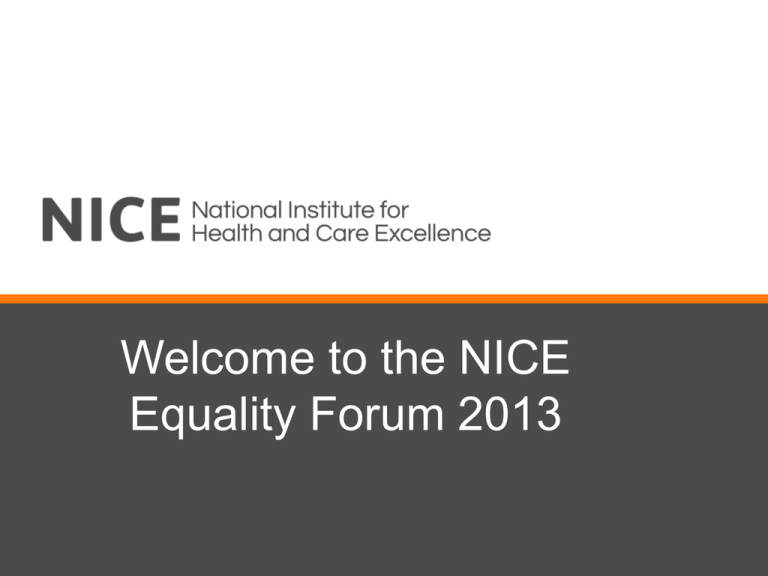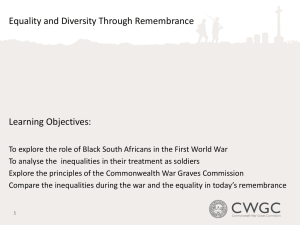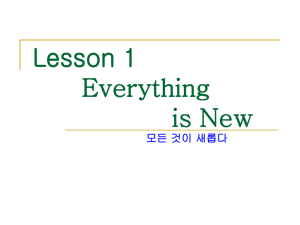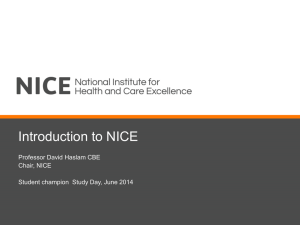
Welcome to the NICE
Equality Forum 2013
Objectives
• Summarise NICE’s progress on equality since last year
and invite feedback
• Seek the forum’s advice on:
– equality issues and opportunities to advance equality that may
arise in the development of NICE guidance on new public health
topics
– how NICE guidance can best support Public Health England,
local government, and voluntary and community organisations to
make the case for local public health strategies and programmes
that focus on advancing equality and tackling health inequalities
NICE’s equality programme in 2013
Nick Doyle
Clinical and Public Health Analyst
About NICE
• We produce guidance on improving health and
preventing and treating ill health, and on social care
• We’re a non-departmental public body (since April 2013)
and no longer part of the NHS
• Local authorities are an increasingly important audience
– for guidance on public health and social care
• We still provide:
– guidance for the NHS on drugs, clinical care, interventional
procedures, medical devices, and diagnostics
– Performance indicators for the GP quality and outcomes
framework (QOF) and for clinical commissioning groups (CCGs)
– online access to evidence through NICE Evidence Services
– advice on medicines and prescribing
NICE’s approach to equality analysis
Equality and
diversity
•Age
•Disability
•Gender reassignment
•Pregnancy &
maternity
•Race
•Religion or
belief
•Sex
•Sexual
orientation
People
sharing
protected
characteristics
Health inequalities
and inequity
Socio-economic
Special
groups
•Social exclusion
•Area-based
deprivation
•Other social and
environmental
factors
For example:
•Homeless people
•Looked after children
•Asylum seekers
Features of the equality analysis
process
• Each item of guidance treated as a separate policy
• Consideration of equality impact progressively shapes
the guidance – from scoping stage to recommendations
• Evidence from patients, carers, service users, the public
and interested organisations essential in identifying
potential impacts on equality
• Aim of diversity in advisory body membership
• Equality analysis findings recorded and published
• Annual reporting of equality issues analysed and impact
on recommendations
Equality programme developments in
2013
• NICE’s first equality objective:
– Research on what helps and hinders the participation
of disabled members on advisory bodies completed
• NICE’s second equality objective:
– Good progress on improving quality of monitoring
data on NICE staff
– Poor results in the annual report lead to new plan on
monitoring data on advisory body members
• Initiatives on involving children and people with learning
disabilities in NICE guidance
Equality programme developments in
2012/13 – continued
• New policy on communicating guidance to groups with
particular communication needs
• Compulsory e-learning programme on equality and
diversity for all NICE employees
• Specialist training for guidance staff on Equality Act
duties
• Report of the 2012 Equality Forum’s workshops on
potential equality impacts of social care guidance topics
circulated to all guidance staff
The public health delivery system
Other government
departments: DfE,
DfT etc.
National
Department of
Communities and Local
Government (DCLG)
Public Health
England (PHE)
Local
PHE’s 4 regions
NHS England’s 4 regions
Directors of PH
Local
authorities
Department of Health
NHS England
NICE
NHS England’s 27
local area teams
PHE’s 15
centres
Supra-local
Chief
Medical
Officer
Health and
wellbeing
boards
Clinical
commissioning
groups
Local Healthwatch
Public health; other council services; social care;
voluntary, community, mutual, private sector providers
Primary
care
NHS trusts and
foundation trusts
NICE Public Health Guidance: promoting
equality and addressing health inequalities
Kay Nolan
Associate Director, Centre for Public Health
Aims
• Brief overview of NICE public health
guidance development process
• How we promote equality during guidance
development
• How we address health inequalities during
guidance development
Centre for Public Health at NICE
• Produce evidence-based guidance and advice
for health, public health and social care
practitioners
– Best quality
– Value for money
– Reducing inequalities and variation
• Local Government Briefings
Audiences for public health guidance
•
The NHS
•
Local government
•
The workplace
•
Education
•
The utilities
•
Industry
•
Retailers
•
DH and other government
departments
•
The public
•
National policy makers
Public sector equality duty - 2010
• Public authorities must, in the exercise of their functions, have due
regard to the need to:
– Eliminate discrimination, harassment, and victimisation
– Advance equality of opportunity between persons who share a
protected characteristic and persons who do not share it
– Foster good relations between persons who share a relevant
protected characteristic and persons who do not share it
• Public sector equality duty: protected characteristics:
Age
Race
Disability
Religion or belief
Gender reassignment
Sex
Pregnancy and maternity
Sexual orientation
What are health inequalities?
• Differences in health state or status between people
due to social, biological, geographical or other factors
• Differences can result in huge variations in expected
length and quality of life
• Some differences, such as ethnicity, are fixed.
Others we can tackle . . .
• Evidence tells us that those in more disadvantaged
circumstances are likely to experience worse health
only those in least deprived circumstances are likely to
have any disability-free retirement
Equal impact for all
A public health
intervention where all are
affected equally means,
everyone’s health state
improves equally…
BUT
The gradient remains the
same and health
inequality has not
changed.
Proportionate universalism
A public health intervention
where the intensity of effort is
signified by the size of the arrow
and determined by the needs of
the group…
The gradient flattens and health
inequality has reduced..
AND
Everyone in the population has
had health gains.
Guidance Development Process
•
•
•
•
•
Topic Selection
Scoping
Development Phase
Validation
Implementation
Topic Selection
• Identify and prioritise which approaches to the promotion
and protection of health and the prevention of ill health
should be the subject of NICE guidance
• Topic is suggested – NICE produces a briefing paper
• NICE convenes a Topic Advisory Workshop
• Refinement of potential referrals – DH
• DH prepare submission to ministers
• Secretary of State for health make formal referral to
NICE
Scoping
• Sets parameters for the guidance
• Specify which or what types of interventions,
strategies or activities are covered, key
considerations for committee
• NICE team prepare draft scope
• Consult on draft scope
• Refine produce a final scope
• Complete an Equality Impact Assessment
Development Phase
• Identification of evidence for review and
consideration and development of draft
guidance
• Reviews – consider equality issues in
development of review questions
• Type of review conducted – e.g. barriers and
facilitators review
• Addressing gaps in the evidence
• Call for evidence
• Expert testimony
Validation
• Consultation with stakeholders on draft
guidance
• Fieldwork
• Revision of the guidance
• Equality Impact Assessment
How does the equality scheme affect
public health guidance?
• Equality impact assessment at key stages
• Involvement of a broad range of stakeholders
• Guidance committees that are more representative of
the population’s diversity
• Chairs responsible for consideration of equality
issues and putting it on record
• Ensure the evidence reviews have addressed areas
identified in the scope as needing specific
consideration
• Ensure recommendations are formulated to avoid
unlawful and harmful discrimination and promote
equality
Key questions in developing NICE
public health guidance
• Are there different burdens of a disease or problem?
(topic selection)
• Are there different baseline risks?
(topic selection, scoping, reviewing the evidence)
• Are there plausible reasons for anticipating differential
effects for particular groups (issues of access?)
(reviewing evidence, drafting recommendations)
• Are there particular cultural factors at work?
(reviewing the evidence, drafting recommendations)
Reducing differences in the uptake
of immunisation
• Immunisation – need to increase vaccination
coverage across whole population to prevent
outbreaks
– National Immunisation Programme delivered through
Primary Care
Consider home visits to discuss immunisation with parents who have not
responded to reminders, recall invitations or appointments. Offer to give
their children vaccinations there and then (or arrange a convenient time in
the future). Such visits could include groups that may not use primary care
services, for example, travellers or asylum seekers.
Preventing type 2 diabetes - risk
identification and interventions for
individuals at high risk
• Evidence shows link between ethnicity and risk of
diabetes.
• South Asian population groups are at equivalent risk of
diabetes to the white population at lower BMI
• Ethnicity is fixed
• Focus on prevention and early identification to reduce
progression of diabetes
Trained healthcare professionals should offer venous blood tests to adults
with high risk scores (stage 2 of the identification process). They should
also consider a blood test for those aged 25 and over of South Asian or
Chinese descent whose body mass index (BMI) is greater than 23 kg/m2
The NICE field team and public health
Steve Sparks
Associate Director, Field Team
NICE Field Team
• Implementation Consultants
• Team of 7 aligned to NHS CB
regions
• 1 in Northern Ireland
• Responsible for a
geographical territory
• Field based
• Provide local connectivity
Keeping up to date
• Sign up for the NICE News
• Log on to the website and register
your details at www.nice.org.uk
• Email steve.sparks@nice.org.uk
•
@SteveSparks
BREAKOUT GROUPS
Q1 Key issues – Equality
• Group A – social deprivation, cultural norms
(cooking traditions, attractive body types),
physical and learning disabilities, mental health
issues. Recommendations need to be
individualised at a practitioner level
• Group B – inflexibility of services, lack of
integration, not designed around person’s needs
• Group C – lots of issues: partly depend on which
chronic conditions, and vary by employment
sector, seniority, gender etc. too
Q2 Key issues –
Development of NICE guidance
• Group A – encouraging stakeholders to register
when they wouldn’t ordinarily consider
participation. Explain why topic is relevant for
them
• Group B – 1. Scoping and mapping exercise:
current practice, definitions. 2. Stakeholder
engagement early on – get the right advice and
buy-in for uptake.
• Group C – importance of data/evidence
disaggregation (by different characteristics)
Q3 Key issues –
Uptake of NICE guidance
• Group A – new PH bodies made more aware of
NICE guidance and how they can utilise it to
maximise benefit
• Group B – joint strategic needs assessment
• Group C – Right Information, Right format, Via
right channels, at the Right time!
Q4 Key issues –
Uptake of NICE guidance
• Group A – dissemination of PH messages to the
public & empowerment for them to take this
forward with practitioners
• Group B – [see Q2: stakeholder engagement
throughout]
• Group C – Importance of regional networks and
3rd sector links to them, and role for
dissemination and evidence collection for older
workers (especially who don’t use the Internet)








